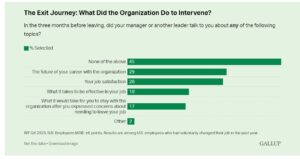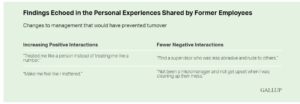According to a recent Gallup study, 42% of employees who left their jobs believe management could have prevented their departure. The study also found that as of May, over half of U.S. workers, 51%, are actively looking for new employment opportunities. Gallup highlighted the substantial cost of employee turnover, noting that the expense of replacing leadership can reach 200% of their salary, while technical roles can cost up to 80% of the employee’s salary to replace.

One of the largest current challenges facing providers is turnover and then in turn, insufficient numbers of staffing. For senior living, I often hear how a lack of staff impacts the ability to grow caseload, grow census, accommodate more clinical complexity, etc. For example, in home health and in hospice, staffing (lack thereof) is the biggest impediment to caseload growth. Staffing levels are not just a factor of recruitment but of retention as well. Arguably, retention strategies which reduce turnover, also improve an organization’s ability to recruit. A couple of years back (2022), I did a presentation for Ohio LeadingAge on healthcare staffing, covering this subject. https://rhislop3.com/wp-content/uploads/2023/03/new-concepts-in-healthcare-staffing.pptx
According to Gallup, the decision to voluntarily leave a job often occurs swiftly. Over three-quarters (77%) of voluntary departures happen either within three months of beginning a job search or without any active job search at all.
Employees often decide to leave their jobs without engaging in proactive communication. Thirty-six percent of those who voluntarily resign report not speaking to anyone before making their decision to quit.
Furthermore, even when employees do discuss their considerations, managers are often uninformed. Forty-four percent of employees who contemplated leaving discussed it with someone other than their direct supervisor or manager before making their decision. Employees were more likely to have these discussions with their coworkers rather than their managers.

Knowing this data, the burden then is on management and organizational leadership to be interventionists in their turnover reduction strategy. If employees aren’t talking to their supervision directly, supervision must be having retention focused conversation with employees. But about what? Job satisfaction elements are the theme.
Almost half (45%) of those who voluntarily left their jobs reported that in the three months prior to their departure, neither a manager nor any other leader had proactively engaged with them regarding their job satisfaction, performance, or future within the organization.
Among those who did have such engagement from a manager or leader before leaving, less than 30% had discussions about their career prospects within the organization (29%) or their job satisfaction (28%). Even fewer reported conversations about what is required to be successful in their role (18%) or what would convince them to remain with the organization (17%).
The typical response from employees that turn over about why they turned over or initially considered it was compensation. This the notion of not being paid “what I am worth or fairly”. In reality, we know that wages and benefits over time are the smallest reason cited when in-depth conversations are had regarding job satisfaction (or dissatisfaction). In a dissected discussion and from various research reports, the effectiveness of management, boils down to the number one cause/reason for turnover. In February, I wrote a post on this issue and the research with it – https://rhislop3.com/2024/02/19/why-managers-need-to-shift-focus-from-putting-out-fires-to-empowering-their-teams/
Regular, meaningful conversations between a manager and their direct reports can significantly increase employee engagement. This is true for all types of workers, whether they are frontline, hybrid, or fully remote. According to research, the most impactful discussions concentrate on goals and priorities, acknowledgment of recent achievements, teamwork, and leveraging employees’ strengths. These conversations, when conducted consistently, can be brief, lasting only 15 to 30 minutes.
Past experience for me, and I have run large organizations (healthcare, senior living) with very little turnover, is that two things matter more than most everything else. First, personal engagement beyond just work conversation (what to do, how it was done, etc.). Staff appreciate when the “boss” knows them and their family, etc., at least, at a macro level. Sharing small stuff around school for kids, vacations, etc., keeps the relationships personal enough to evidence “care” as a component of work life.
Second, providing frequent recognition and reward. Reward can and should be variable and frankly, small and personal works best. With feedback, like a “good job” done note, a small reward can be powerful. I’ve used everything from movie tickets to gas cards, to coupon books, a day off with pay, to a coupon for coffee in the company cafeteria. A handshake, a pat on the back, a note and a reward, even trivial, is a reason to stay connected and to show the employee that their work is noted and appreciated. If all “bosses” work at this concept, reward 10 to 1 before a negative interaction, turnover will reduce.

The referenced Gallup study information is available at this link – 42% of Employee Turnover Is Preventable but Often Ignored (gallup.com)